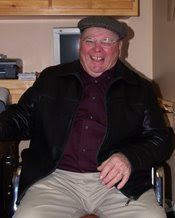Pulling the boards into place is not easy--so often we drive a chisel into the subfloor and use it to ratchet the boards tight for nailing. It always works better with 2 workmen.

Thresholds and in particular nosed thresholds at the top of stairs should look like the existing stair treads. You can rip a piece, glue, nail and screw to emulate the same look in most cases. Hide your screws where you can.
 Casings and jamb extensions will often need trimming so that the flooring slips under and doesn't leave an unsightly gap. We use a flush cut backsaw (a saw that cuts on the pull stroke--Japanese steel preferred), and rest it on a piece of the actual flooring for a guide.
Casings and jamb extensions will often need trimming so that the flooring slips under and doesn't leave an unsightly gap. We use a flush cut backsaw (a saw that cuts on the pull stroke--Japanese steel preferred), and rest it on a piece of the actual flooring for a guide.
 This is a pneumatic stapler. You still trigger using the mallet, however it does some of the work for you and shoots a staple with excellent holding power. These two are working in tandem...one holds the board tight with a chisel (an old one), and the other fastens using the pneumatic nailer.
This is a pneumatic stapler. You still trigger using the mallet, however it does some of the work for you and shoots a staple with excellent holding power. These two are working in tandem...one holds the board tight with a chisel (an old one), and the other fastens using the pneumatic nailer. This floor is being put down over a good solid softwood floor... this makes an excellent base. Every board is glued down to prevent squeeks. IN the old days they would use a layer of building paper to prevent squeeks.
This floor is being put down over a good solid softwood floor... this makes an excellent base. Every board is glued down to prevent squeeks. IN the old days they would use a layer of building paper to prevent squeeks.
 We always start with a clean chalk line and in this case we would be fitting a threshold to the entrance door later, so we trimmed off the lower part of the groove to make it easier to fit later.
We always start with a clean chalk line and in this case we would be fitting a threshold to the entrance door later, so we trimmed off the lower part of the groove to make it easier to fit later.  The first couple of rows get surface nailed typically... set the nails well below the surface though, and make sure the first board remains aligned to the chalk line.
The first couple of rows get surface nailed typically... set the nails well below the surface though, and make sure the first board remains aligned to the chalk line.





